The Dragon and the Eagle:
A Romantic View of the Survival of the Western Roman Empire in
Britain,
in parallel with the Survival of the Eastern Roman Empire in
Byzantium.
Last
updated: 25th April 2021.
In the rest of this web site I have used a definition for the Roman
Empire which means that the Western Empire fell in 476, and was revived
by Charlemagne in 800. Apart from a gap from 924 to 960, it then survived
until 1282 (by which time it was known as the Holy Roman Empire), when
Rome became indepedent under the Pope. A different, more romantic view
grants the role of legitimate successors to the Roman Empire in the
West to the Britons, who long maintained their independence in Wales.
The justification for this whimsical idea is that:
a) Uniquely among the peoples of the Western Empire, the citizens of
Britain were explicitly instructed to defend themselves, by Emperor
Honorius in 410.
b) Uniquely among the peoples of the Western Empire, the citizens of
Britain did maintain their freedom against the Germanic invaders, for
the best part of 1000 years.
Both of these justifications can be questioned. Regarding (a), The
exact signficance of the "Honorian Rescript" of 410 is disputed.
Presumably it was felt necessary because of the law preventing Roman
civilians from bearing arms. But in any case the Emperor Valentian
revoked that law in 440, in the face of widespread attacks by Germanic
nations. Regarding (b), the Basques also maintained their freedom after
the fall of the Western Empire, throughout most of the middle ages.
Their Kingdom of Navarre was only divided between Spain and France in
the 16th century. However it should be noted that the name
"Welsh"
(from which came Wales and Cornwall) derived from the Germanic word
for "Romans" --- it is cognate to Waalsch
(the Dutch word for the Walloons,
their Romance-speaking neighbours in Belgium), to Welsche (until recently the German
word for all their Romance-sepaking neighbours, still used in Swiss
German for French-speakers in Switzerland, and by German-speakers in
the Tyrol for Italians), and to Wallachia
(the part of Romania bordering on German-speaking settlements in
Hungary).
So, unlike the Basques, the Britons were regarded as "Roman", at least
by their German neighbours.
Regardless of whether there is any real justification for
considering the Britons as the true heirs to Rome in the West, it is
interesting to compare the fate of the Britons and the Byzantines
(successors to Rome in the East) in the Middle Ages. Just as in
the East, the fortunes of the Britons rose and fell a number of times
over the millenium from the 5th to the 15th century. This web page
charts those fortunes, which surprisingly often moved in parallel.
Because their territories never overlapped, a single map is used to
display the territories of the Britons, and the Byzantine Empire, at
various times. Note, however, that the dates for East and West are rarely
exactly the same, although they are typically within a generation of
one another. Note also that there is no implication that the
territories of the Britons had a single monarch, unlike the Empire.
However, because this page is a "romantic" vision, I have taken the
liberty of discussing the territories of the Britons in 530 as being
dominated by Arthur, their famous war-leader, and speculating generously
(although not impossibly so) as to the power of the Britons in Britain
and Gaul at that time.
Most of the maps below reproduce the Byzantine Empire at times shown
the 18
centuries of
Roman Empire page (albeit rotated
relative to the maps on that page). One, however, is new: that for the
Byzantine Empire in 633.
Note: to view these maps as a
coarse "movie", first adjust the size of
this window to be slightly larger than a map plus its title, then click
on next (>) or previous (<) at the beginning of each title. To
return
to the Index of Maps, click on the up arrow (^).
Index of Maps
530 / 565 -- Maximum: Arthur and Justinian.
630 / 623 -- Attacks from the east: Saxons and
Persians.
634 / 633 -- Fleeting Victory: Cadwallon and
Heraclius.
786 / 756 -- Retreat and Fragmentation.
940 / 1040 -- Consolidation and Expansion.
1099 / 1091 -- Blitzkrieg from the east: Normans and
Turks.
1154 / 1167 -- Recovery: Owain Gwynedd and Manuel Comnenus
1409 / 1453 -- The End: Owain Glyndwr and Constantine Paleologus
^ > 530
/ 565 -- Maximum: Arthur and Justinian.
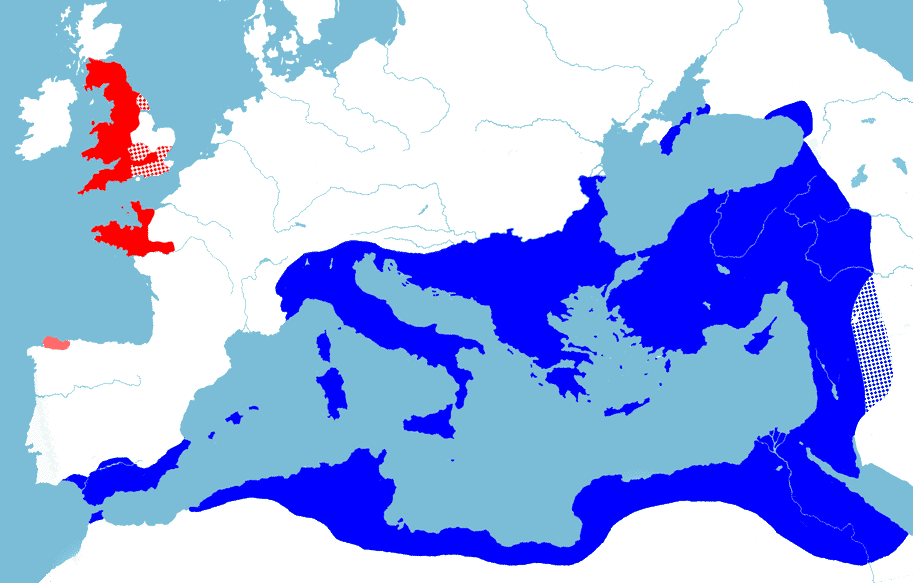
In 410 the cities of Britain, under heavy Saxon attack, were told by
the Western Emperor Honorious to fend for themselves. This they did
with greater success than any of the other peoples of the Western
Empire. By 486 all of these other peoples (except the Basques) had
fallen under the rule of Germanic invaders, while the Britons still
controlled most of the diocese of Britain. Much of the east had been
lost to German tribes (chiefly Angles, Saxons and Jutes), some of whom
had arrived as mercenaries a generation or two earlier. Some of the
displaced Britons had fled overseas, founding colonies in Armorica
(which were independent) and in northern Spain. The latter acknowledged
Suevic (and later Visigothic) suzerainty and hence are shown in
light red. Around this time, the Britons were led by Ambrosius
Aurelianus, remembered as the last of the Romans. According to Welsh
accounts(*), he was succeeded by the war-leader Arthur who won great victories
against the Saxons, perhaps in the early 6th century. The map above is
a speculative and generous estimation of British territory in the
aftermath of these victories. Saxon
lands are shown as subject to the Britons (speckled) since, according
to the Byzantine historian Procopius, Britain at at this time
had three kings: a king of the Britons, a king of the Angles, and a
king of the Frisians (in Kent perhaps). Frankish texts also contain hints
that there was a resurgence of
British power in Armorica, particularly along the Loire, in the mid 520s.
According to one history of the Armorican Britons(**), Arthur also had
victories in Gaul. Not long afterwards, the Eastern Roman or Byzantine
Empire under Justinian also began reconquering the West from its German
kings. It reached its maximum at the time of his death in 565.
(*) Written around 300 years after the event. The same history,
reputedly by Nennius, is also
our first record of the red dragon
as the symbol of the Britons. It may have derived from the serpentine
windsock of the Roman cavalry.
(**) Written perhaps in 1019 (almost 500 years after the event),
or perhaps even later. If it was written after 1135 then this
claim was probably derived from the
false history of Geoffry of Monmouth, and can be dismissed.
< ^
> 630 / 623 --
Attacks from the east: Anglo-Saxons and Persians.
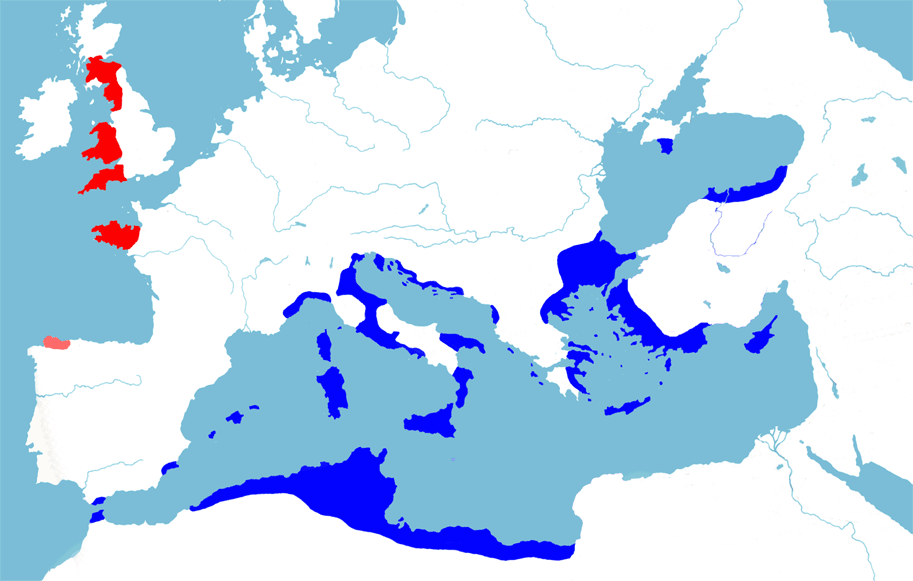
The Britons' gains were lost within a generation as they fell
into civil war. By the early seventh century, the Saxons (as the Britons
called, and still call, the Germanic-speaking nieghbours in the
Island of Britain) had pushed westward to the sea, reaching the Bristol
channel and the Irish sea. Around 630 Edwin, king of the Angles of
Northumbria, captured the Isle of Man and Anglesey in the latter.
Welsh tradition says that he forced Cadwallon, king of Gwynedd
(the foremost British kingdom) into exile in Ireland.
In Gaul, the Franks also pushed the Britons
westward, into the Armorican peninsula known ever since as Brittany
(little Britain). Meanwhile, by the early seventh century, the Byzantine
Empire lost most of its territory in Spain, Italy, and the the Balkans,
to the Visigoths, Lombards, and Avars, respectively. Taking advantage of
wars between rival Emperors, the old enemy in the east, Persia, also
attacked. By 623 the Persian king Chosroes had captured all Byzantine
territory from Egypt to eastern Anatolia. A few years later the
Persians and the Avars besieged Constantinople. But the Emperor
Heraclius had already left with his army by sea to begin a
counter-offensive.
< ^
> 633 / 633 --
Fleeting Victory: Cadwallon and Heraclius.
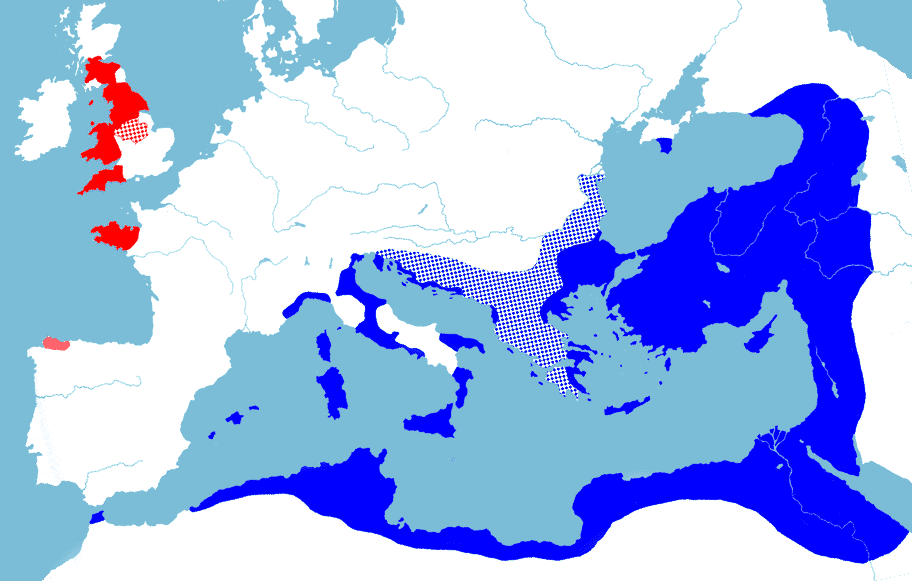
Cadwallon returned from exile, and raised a new army for a
counter-offensive against Edwin. He enlisted (perhaps forcibly) the aid
of Mercia, the neighbouring Angle kingdom, ruled by Penda. On the 12th
of October in 632 (or possibly 633), Cadwallon defeated and slew Edwin. He then proceded to
ravage the Angles of Northumbria, seemingly to exterminate them. Only Bernicia, the
rump of the Northumbrian kingdom north of
Hadrian's wall, remained unconquered. The Byzantine Empire under Heraclius
also made a seemingly miraculous recovery. Heraclius defeated the
Persian forces in their heartland, and they overthrew their own king
Chosroes and sued for peace. The Avar hegenomy in the Balkans
collapsed. By 633 the eastern frontier was fully restored, and the
Slavs in the Balkans (former subjects of the Avars) were brought to
heel also.
< ^
> 786
/ 756 -- Retreat and Fragmentation.
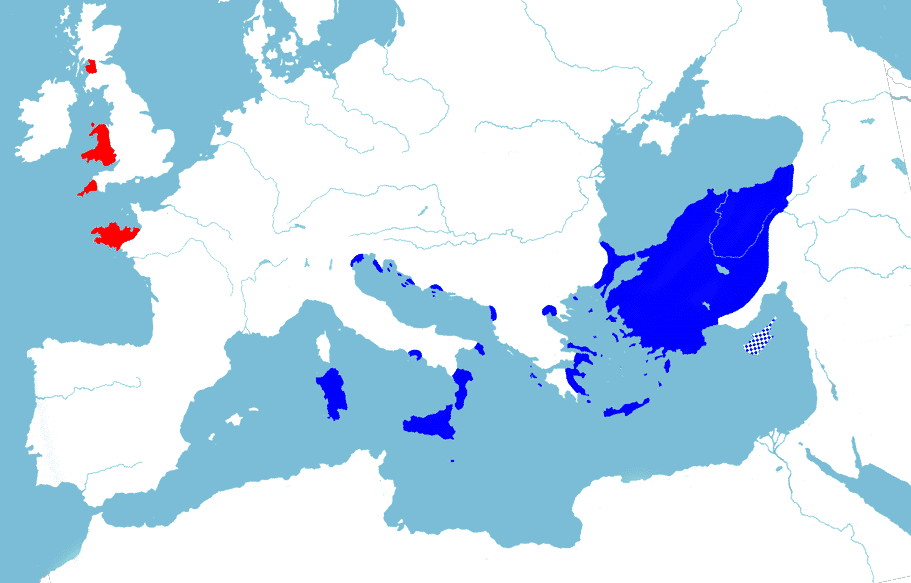
Cadwallon's reconquest turned out to be fleeting. A Prince of Bernicia,
Oswald, offered him battle near Hadrian's wall, and this
time it was Cadwallon who was slain, in 634. Oswald took back all of
Northumbria, and the Britons retreated into Wales (although they
continued to war against Northumbria with their Mercian allies until
Penda's death in 655). By the mid eighth century, the Northumbrians had
reduced the Britons in the north to the tiny kingdom of Strathclyde,
centred on Dumbarton (the fort of the Britons). In the south, the West
Saxons pushed the Britons westward into Cornwall, and in Gaul, the Franks under
Charlemagne conquered the eastern parts of Brittany. Similarly,
Heraclius' reconquests fell apart within a few years of his victory, when the Arabs
attacked in 633. By the mid eighth century, the Empire was reduced to a
core consisting of Anatolia and coastal Thrace, plus various islands
and coastal regions that the Empire's navy protected from the Caliphate.
< ^
> 940 / 1040 --
Consolidation and Expansion.
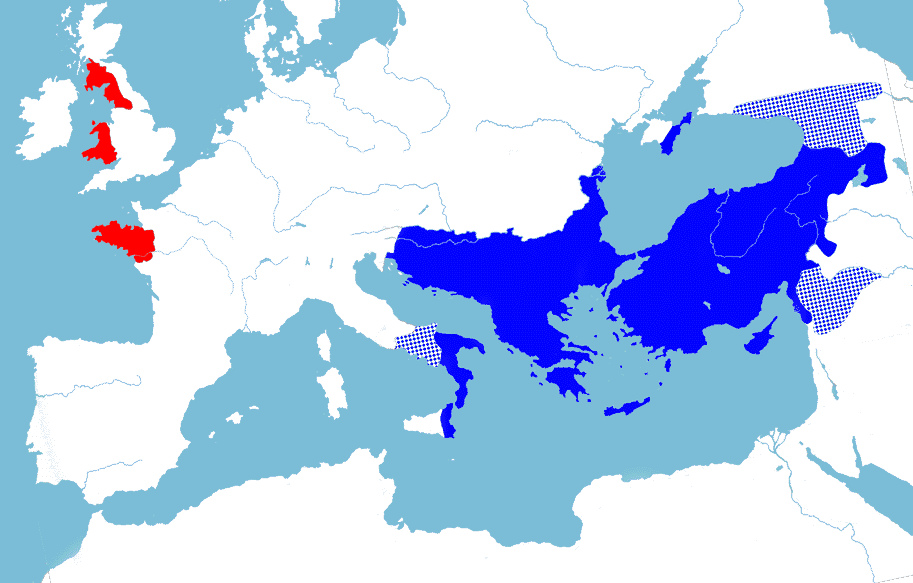
In the ninth century, attacks by Norsemen on the Anglo-Saxon kingdoms
gave some relief to the Britons, except in Cornwall which was annexed
by the West Saxons. In the tenth century the Britons consolidated their
territories into three large areas, each for the most part with a single ruler.
The Britons of
Strathclyde under king Dyfnwal (Donald) (937-45) were able to advance
their kingdom
southwards as far as Leeds(*). Apart from minor kingdoms in the
south-east, Wales around this time was ruled by a single king, Hywel
the good (942-50). In Gaul the Britons had also consolidated under a single
ruler, and were once again a force to be reckoned with. By 867 King Salomon
ruled an area almost as great as that shown in the map for 530, and his
royal status was acknowledged by the king of France. In the early tenth
century the country was overrun by Vikings, but Alain Barbetorte
(938-52) restored British rule to all of Salomon's kingdom except the
Normandy peninsula. However, he styled
himself Duke, not King. Meanwhile the Byzantine Empire had also
recovered from its nadir in 756, as the Muslim world
progressively lost its politcal unity from then onwards. Its only
permanent losses from its position in 756 were parts of Italy and its
Islands.
(*) According to an account of the Life of Saint Cathloe, which
seems to imply a date close to 940, at the intersection of the rules of
Constantine of Alba (900-943), Dyfnwal of Strathclyde (937-45), Erikir
of York (perhaps 937-940, appointed by Aethelstan according to a Saga),
Edmund of England (939-946) and Oda of Canterbury (941-958).
< ^
> 1099
/ 1091 -- Blitzkrieg from the east: Normans and Turks.
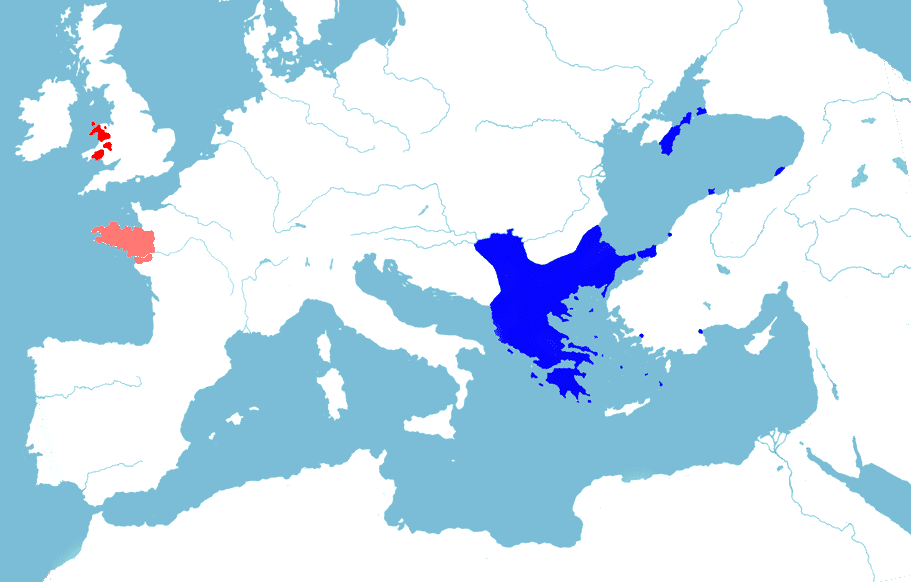
Strathclyde could not keep its southernmost conquests from England,
although it did retain Cumbria (so-named after the word the Britons
used to refer to themselves, Combrogi, meaning people of the same
land). Strathclyde came under the protection of Scotland, and was
peacefully annexed to it probably around 1016, on the death of its last king, Owain
the bald. Across the sea, the rulers of Brittany were also peacefully losing
their British identity. From 958 to 1166, the Duchy was ruled by
the Count of Rennes, a French-speaking city that had been annexed to
Brittany in the 9th century. But the story in Wales was not so
peaceful. Not long after their conquest of England in 1066, the Normans
turned to Wales. When Rhys ap Tewdwr, king of Deheubarth (southern
Wales) was killed in 1093, the Welsh chroniclers recorded it as the end
of the Kingdom of the Britons. Therafter they referred only to Cambria,
or (borrowing from English), Wallia. By 1099 much of Wales had been
conquered and castellated by Norman lords; only fragments remained
under native princes. The Byzantines also suffered a Blitzkrieg from
the east at this time: the Seljuk turks had smashed their army at
Manzikert in 1071, and occupied almost the whole of Anatolia by 1091.
Elsewhere various Slav nations (Bulgars, Serbs, and Croats) regained
their independence from the Empire, and southern Italy was lost to the
Normans.
< ^
> 1154 / 1167
-- Recovery: Owain Gwynedd and Manuel Comnenus

Surprisingly, the Britons in Wales recovered and expelled the Normans
from all except the south of their country. Civil war in England
enabled Owain Gwynedd to dominate the country by 1154. He was the last
British leader to style himself King (of Wales), and also the first
recorded as Prince of the Welsh. The Byzantine Empire also recovered,
but only with help from the West in the form of the first crusade
against the Turks. Much of Anatolia was reoccupied, and Bulgaria and
Serbia brought back into the fold. By 1167 Emperor Manuel Comnenus had
received the submission of Lesser Armenia and the Crusader states on former
Byzantine soil, and defeated Hungary to regain control of
Croatia.
< ^
1409 / 1453
-- The End: Owain Glyndwr and Constantine Paleologus

In 1166 the Dukedom of Brittany came under the rule of the Henry
Plantagenet (who also held the English crown), and from then on was
dominated by foreigners. It was eventually annexed to France in 1532.
By contrast, Wales continued to produce native rulers, several of whom
took the title Prince of the Welsh, or Prince of Wales. The most
powerful (his position and territories were recognized in 1267 by
treaty with the English king Henry III) was Llywelyn ap Gruffudd. But
he is also known as Llywlyn the last, because Edward I, son of
Henry III, conquered all of Wales and caused his death in 1282. The
title Prince of Wales was thereafter to be bestowed upon the Crown
Prince of England. But the Principality of Wales was not quite dead.
More than a century later, in 1400, a Welsh noble, Owain Glyndwr,
raised the standard of rebellion. Again taking advantage of civil
strife in England, his strength grew rapidly. In 1404 he called a
Parliament and was crowned Prince of
Wales, and by 1405 held the entire country apart from a few castles.
But the English Prince Henry (later crowned as Henry V) changed
tactics, blockading Owain, and by 1409 had
reconquered most of Wales (as shown here). Glyndwr was reduced to a
guerrilla leader, and disappeared a few years later, never
to be seen again. Thereafter Wales remained firmly under English rule,
and was formally annexed in 1536.
Similar events overtook the Byzantine Empire. After Manuel it suffered
from weak Emperors, and through Venetian trickery Constantinople fell
to the army of the 4th Crusade in 1204. Crusader states were
established in the Aegean region, with a Latin "Emperor of Romania" in
Constantinople. The ruler of the strongest of the Byzantine successor states,
Michael Paleologus, was restored as Emperor in Constantinople in 1261,
and most of the Crusader territory reconquered. The
restoration of the Byzantine Empire was far longer lived than its Welsh
analogue, with the Paleologus dynasty ruling for almost two centuries
more. The eagle had been
the symbol of Rome's legions since the
time of Marius (104 B.C.), but the Paleologi adopted the double-headed eagle as
their Imperial insignia. The last reigning Emperor in Constantinople
was Constantine Paleologus, who died during the fall of the city to the
Ottoman Turks in 1453. His brother, Thomas, despot of Morea (southern
Greece) then claimed the Imperial crown, but he lost his despotate to
the Ottomans in 1460. His daughter Zoe Paleologa was married to Ivan
III of Russia. Thus was introduced the double-headed eagle as a symbol of
the Russian Crown, and the idea of Moscow as the "third Rome". But that
is one too many romantic ideas of the survival of the Roman Empire for
this web page.
The Dragon and the Eagle in the Middle Ages: Summary Map
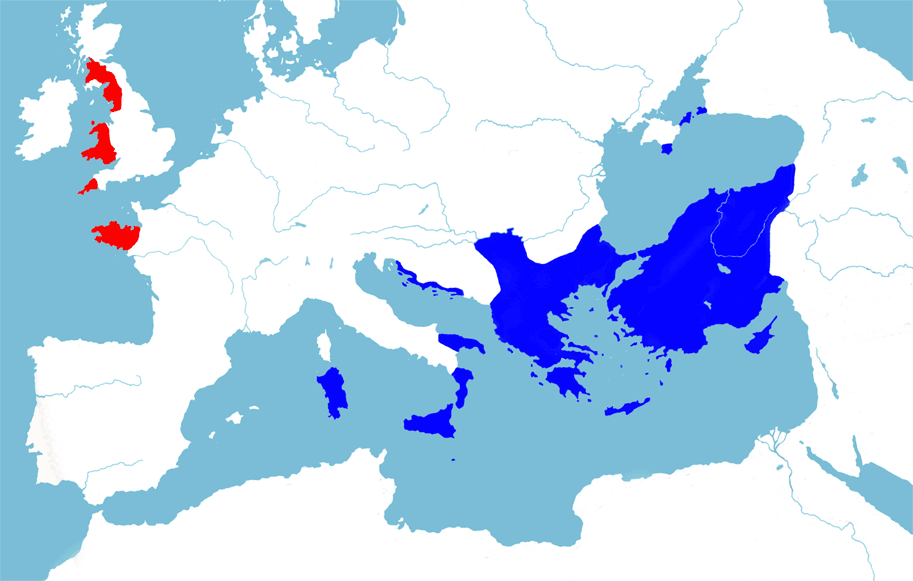
This map shows those areas that are common to at least four of the
eight maps above. That is, it should represent the "typical" extent of
the realms of the Britons, and the Byzantine Empire, in the Middle Ages.
The only anomalous feature of this map is the fact that the Byzantine
Empire reaches as far as the Danube, in what is now Serbia. The four
main concentrations of Britons, in Strathclyde+Cumbria, Wales,
Cornwall, and Brittany, are clearly displayed.
Return to the Roman Empire main
page








